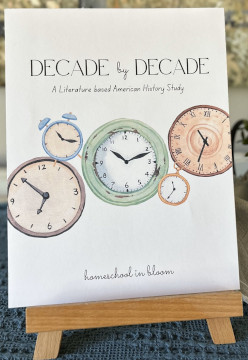Decade by Decade, by Kirstin Bloom, takes a Charlotte-Mason, unit-study approach to studying U.S. history from the late 1800s through the 1960s. It is best for ages six through nine, although younger and older children might want to join in. The course guide is sold as a PDF, and it’s up to you to gather other resources you will use.
History is the primary topic, but science, art, and language arts activities might provide sufficient coverage of those subjects for students in the primary grades. The course uses chapter books (for read-aloud time), picture books, information books, historical videos, movies, experiments, crafts, art, and cooking—all with lots of discussion.
In addition, students create a notebook for their written or transcribed narrations, timeline entries, and copywork. Notebook work provides practice in handwriting, composition, grammar, and spelling, as well as art. (You might want to add specific instruction for language arts as needed or use more comprehensive resources.) The course doesn’t include formatted timeline pages or images, so students can create timeline entries individually in a section of their notebook or on a continuous roll of paper or other displayable option. The coursebook does provide lists of people for each unit as “Timeline Pictures to Print,” and Bloom suggests downloading and printing images from the internet.
Most of the course’s eight units cover one decade each. (The first unit, the late 1800s, covers a bit more than a decade.) Each unit should take 12 to 14 days to complete, and planning a month per unit should allow plenty of time for pursuing interesting topics, taking field trips, or spending extra time on fun activities.
Decade by Decade lays out lesson plans on charts for each unit and leaves it to parents to decide which days they will use them. Using them three or four days per week will suffice, but the activities might take up a substantial part of your school time on those days.
The course uses many books, but you should be able to borrow many from the library and some are available on Hoopla, the free public library platform (with ebooks, audiobooks, and other content). You might want to purchase the book 100 Inventions That Made History by Clive Gifford since it’s used throughout the course. Parents can substitute different books if they want to, so there’s no problem if a particular book can’t be found.
Each unit also has its own booklist with books listed under the headings Chapter Book, Reference, Inventions, History, Poetry, and Independent Reading, plus headings for key people or events to be studied, such as Alexander Graham Bell and Thomas Edison for the first unit and Ellis Island, Theodore Roosevelt, Flight, and Henry Ford and Early Automobiles for the second unit. The emphasis is on societal development, key people, and inventions more than on wars and world events.
In addition to the lesson plans and booklists, every unit lists one or two movies (or tv shows) that can be enjoyed by the family and several historical videos (free, online videos with speeches, commercials, drawing classes, old evening news excerpts, music, and History Briefs from Reading Through History). Every unit also has at least one science experiment and one craft, both with instructions. Some experiments include graphic organizers for children to complete afterward. Some units include a poem, hymn, or speech excerpt. Every decade study concludes with a Decade Dinner that children help prepare using the recipes and menus provided in the book.
Don’t miss the End of Year Project Ideas beginning on page 111 and suggested field trips (all in the eastern half of the U.S.) on page 114. Optional, Charlotte-Mason-style Exam Questions on page 115, such as, “What was your favorite chapter book we read?”, can be used for informal assessment.
There is some minimal Christian content, such as Fanny Crosby’s hymn “To God Be the Glory,” but the course should be useful for any family looking for uplifting and wholesome content.
Parents should adapt activities to suit their children, such as writing down a child’s oral narration if he or she lacks the writing skill or choosing a shorter read-aloud book if the one or two recommended books seem too long. (Alternate suggestions are sometimes provided.) Twenty to thirty picture books are listed for each decade, so there are plenty of books that young children will enjoy.
Like most unit studies, Decade by Decade requires preparation time and parental involvement throughout many of the activities. However, students too young for all the activities will probably also want to listen to and see the picture books and participate in experiments, crafts, and cooking. So the time parents invest might serve the whole family and not just school-age children.
Summary
Decade by Decade’s “people and inventions” approach to history is great for young students, especially because it’s taught through picture and information books.









